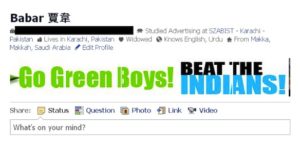Taking Back Control: Social Media and Marketing
By Babar Javed | Business | Published 13 years ago
 If any business function is to be charged with using social media to engage with customers, usually it is the marketing department. Unfortunately, most senior marketers view social media as a space for entertaining youth, and nothing more. What they don’t realise is that along with the entertainment value of user-generated content, much of the output revolves around some brand or popular culture item that is ridiculed or criticised. The manager that does not stop this is faced with a crisis. And to top it all off, an inability to understand the source of the content and how to communicate with both the creators and viewers can cause the perception of the brand to spiral out of control. It is, as they say, able to live on its own.
If any business function is to be charged with using social media to engage with customers, usually it is the marketing department. Unfortunately, most senior marketers view social media as a space for entertaining youth, and nothing more. What they don’t realise is that along with the entertainment value of user-generated content, much of the output revolves around some brand or popular culture item that is ridiculed or criticised. The manager that does not stop this is faced with a crisis. And to top it all off, an inability to understand the source of the content and how to communicate with both the creators and viewers can cause the perception of the brand to spiral out of control. It is, as they say, able to live on its own.
An example of brand-damaging user-generated content is the “United Breaks Guitars” video on YouTube (see below). It’s a light-hearted music video with a powerful message: it alleges United Airlines recklessly handles and damages passenger baggage. In the song, a musician recounts how the US airline was caught throwing his and his band mates instruments: a guitar was broken, and the airline showed no sympathy and offered little recourse. The video is a reply to the poor customer service the singer-songwriter received. It has generated over 10.2 million hits.
It is clear that these days, marketers have lost control over how and when their products are presented to potential customers. The modern consumer now compares product features, prices, store locations and after-sales service reviews with peers in online communities. One way we recommend enhancing a customers’ propensity to purchase your brand is via the combined use of unique customer-generated content, user reviews and recommendation algorithms that together will allow you to build trust. Browsers are familiar with this tactic, which is heavily utilised by online retailers.
In September 2010, 15 million fans were awaiting the release of the latest instalment in the Halo franchise: ‘Halo Reach.’ Bungie Studios, the maker of the popular video game, commissioned an unusual social media campaign for Spain from the ad agency Diluvia. Together, they decided to hype the new edition and engage with fans through an online competition. The goal was to reward a loyal Halo player with the privilege of dubbing the voice of one of the characters in Spanish. The idea, called “First Voice Donation Campaign,” started with a ‘Halo Reach’ Facebook profile to announce the event and connect with thousands of fans. Those eager to participate were asked to shout “Halo Reach” for as long as they could. Bungie went on to create an exclusive YouTube channel where users could track “voice donations” every minute to comment and rate them. In just four days, the campaign generated more than 3,000 donations, 20,000 subscribers on the YouTube channel and nearly 25,000 fans on Facebook. The winner, decided by the engaged community, was Alejandro Dobson. The game made nearly a quarter of a billion dollars on its release date.
Here’s something else to consider: fan favourite campaigns must have a strong psychographic understanding of the social media generation: specifically, their constant urgency and sense of impatience. Keeping this in mind, limited-time offers need to be advertised on high-traffic sites to those within the vicinity of the participating stores. Airlines, including Air Arabia and Thai Airways, have begun using Facebook and Twitter to promote last-minute flight deals, or announce duty-free shopping spree allowances — tasks ideally suited to the dynamic environment of social media. The Penny Arcade store sometimes focuses on selling one discounted item from their online shelf based on the theme in the day’s comic or topic.
Of course, there are local examples of how social media is being used in marketing too. In mid-March, in the lead-up to the Pakistan-India semi-final showdown at Mohali, a beverage giant based in Pakistan (name withheld on request for competitive reasons) wanted to spark excitement for the big cricket match using social media. Strategists at Sociality360 found a way to utilise the new Facebook user interface and profile layout that features five pictures above the wall: our employees tagged over 100 relevant profiles from their “friend lists” for the first guerrilla profile takeover. The tagging was for cricket enthusiasts, outspoken commentators and sports reporters, and they all became advertising vehicles for a message of encouragement addressed to the Pakistan cricket team that physically covered that new five-photo block on users’ walls. Interestingly, the beverage company behind the cricket promotion left their logo off the “ad.” And the image wasn’t linked to a corporate page either. With no monetary benefit expected, the company genuinely wanted to hype the match. The result: this smart utilisation of Facebook was praised by multiple digital and full-service agencies, and the users ended up tagging everyone they could as the day of the match drew closer to show the Pakistani team their support. And the cost? Simply, the morning shift for two Sociality360 employees.
How Social Media Can Be Used Against Your Brand
Click play to watch the video:[youtube]http://www.youtube.com/watch?v=5YGc4zOqozo[/youtube]


